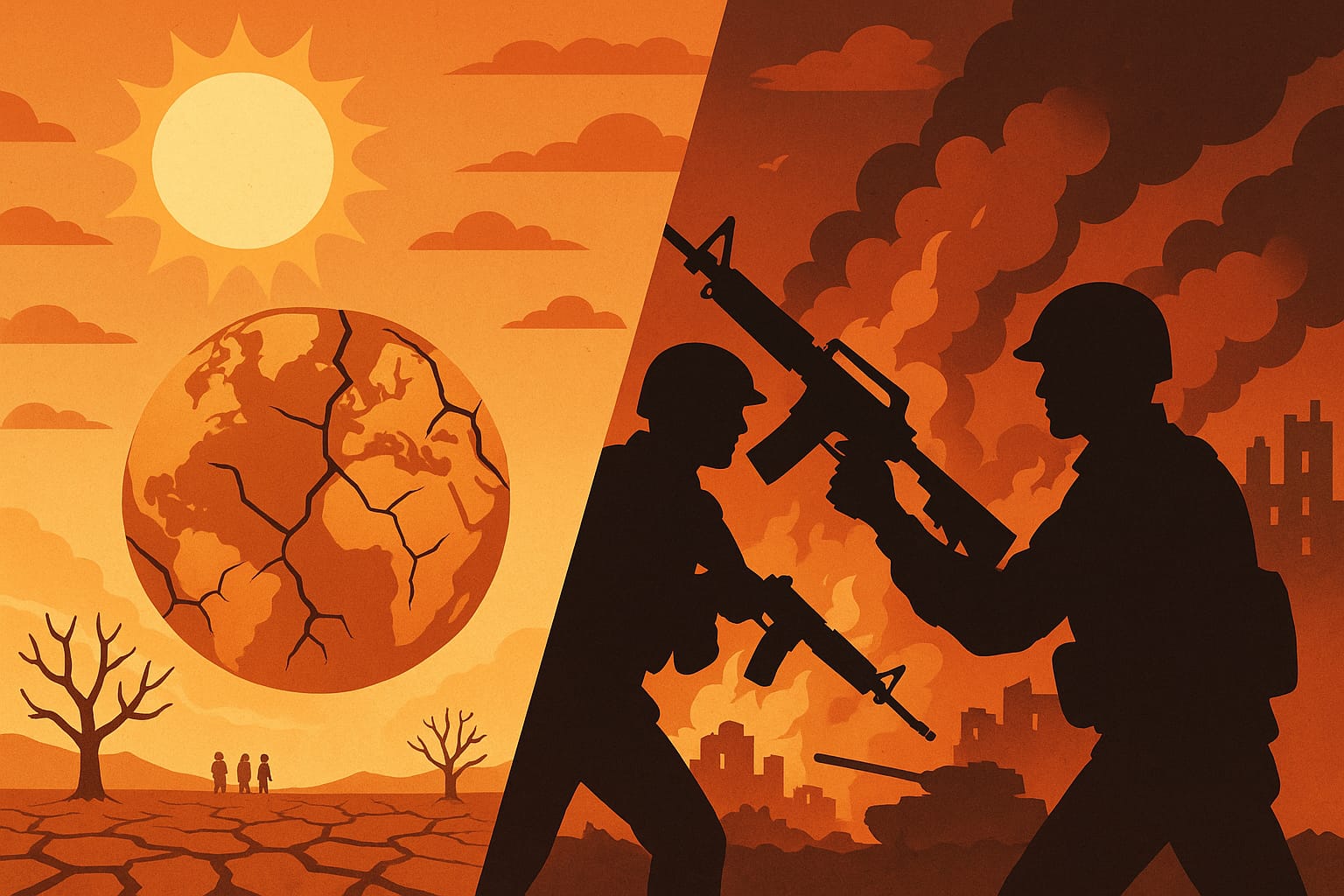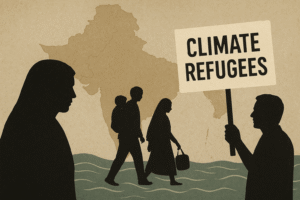Climate Induced Conflicts: A Threat to Peace

Climate Induced Conflicts: A Threat to Peace
Climate change is not only affecting us and our environment in a simple linear way. But it is also playing a role as a threat multiplier in indirect ways among nations. Climate induced conflicts are the results of this changing behavior of nature due to unsustainable anthropogenic activities.
In the past eras, conflicts were based on races, religion, and power but now the trigger behind a conflict is climate change in many ways. Either it is in the depth of a conflict because of the migration and resource scarcity after a natural disaster or whether it is rooted in tension among the developed and developing nations for demanding climate finance. Everyone is trying to blame another but no one is ready to admit and act. This blame shifting and lack of cooperative actions is destroying the element of peace and stability on a global scale. Every individual’s actions account for this happening, we call climate change.
Climate induced conflicts are not only arising disputes among nations but also within a nation. Marginalised communities within a nation are more affected by climate change while they have a very less contribution to it. The reason behind this situation is they don’t have means to adapt and prepare. The poor governance and lack of social investment in areas such as development, health and education leads to injustice and ultimately a threat to peace. The extreme weather events such as droughts and floods resulted in displacement of vulnerable communities. These migrations exacerbate unavoidable food shortage, security issues and resource scarcity, then there is likely to be an increase in pre-conditions for conflict and violence to take place.
According to NIH publication in the Journal of Research in Medical sciences, catastrophic events due to climate change can also result in crimes — an obstacle for peacebuilding. Various studies show that there is a condition of mental distress and hopelessness among the affected individuals of natural disasters. In the context of Asia, which is the region where half of the world’s population lives, there is a higher risk of dual crisis: conflict and climate. The latest World Risk Report places various Asians countries including Pakistan alongside Philippines, Myanmar, Afghanistan, India and Bangladesh among the top risk hotspots for disasters.
Pakistan is one of the most important Asian developing countries and a case study for climate induced conflicts The geographical makeup of Pakistan, from high glacial mountains to low lying floodplains make it prone to extreme weather events. These climatic conditions are interwoven with socio-economic inequality and political instability. Pakistan is facing this dual crisis in two ways. One of them is the tension and disputes between the regions of North Punjab and South Punjab.
North Punjab comprises districts such as Rawalpindi, Attock, and Chakwal. These areas benefited from high rainfall, a better canal system and temperature ranges which support high crop yield. In contrast, the Southern Punjab regions such as Multan, Bhawalpur and Dhera Ghazi Khan are experiencing low rainfalls, extreme droughts and heat waves. Farmers of Southern Punjab migrated towards Northern Punjab which resulted in increased urban pressure and social unrest with scarce resources. Moreover, the adaptation strategies and development funds are not invested evenly in northern and southern Punjab. Northern Punjab is more developed and less impacted by climate change. These sociopolitical conditions and escalating climate change undermine the peace, unity and sustainability within the nation.
The other way is the escalating conflict across boundaries such as between India and Pakistan on water scarcity. Melting of glaciers in the Himalayas mountain range due to global warming and changing rain patterns threaten water availability and increase the stress on the Indus basin – a common water treaty between India and Pakistan. Despite the Indus Water Treaty (IWT) agreement 1960, there is a tension between both these nations due to competition over limited water resources.
Pakistan resisted the projects of the Indian nation to build Kishangana and Baglihar dams on Neelam and Chenab rivers respectively. The reason behind this is the fear of water scarcity because this allows India to control water which is a concern for Pakistan’s agricultural lands near the Indus River. And climate change at the back of this situation is magnifying the conflict through extreme drought conditions and changing river flows.
And this conflict sprawl along with climate change is not stopped here. It is expanding throughout Asia and all the other 6 continents in this world map. The catalysts are lack of resources, weak disaster risk management, injustice, fragile government and lack of shared goal approach among the nations.
It is not about a thought that climate change is causing all the conflicts but it acts as a breeding place and a catalyst for conflicts, violence, threat and anxiety. We have to take this changing force in a positive way and instead of fragmented and disputed nations we have to unite for a common cause towards resilience and adaptation for a sustainable planet.
Building a peaceful and sustainable Asia requires coordinated and multifaceted strategies that can address both immediate risks and long-term drivers of conflicts. Climate change amplifies the existing tensions over land, food, water and migration which are the results of lack of a state’s cohesiveness, stability, government and preparedness. So effective solutions are required that not only resolve the problem in a narrow environmental management approach but can also embed this within the context of peacebuilding and regional cooperation.
First, encouraging the solutions and strategies which can promote regional cooperations on transboundary resources. This is a way step forward to bridge the divides and foster unity among nations. Through this action a sense of security and compassion will be created among nations. This holistic approach is necessary because there are many essential rivers in the continent of Asia which have no distinct boundaries and sustain millions of people. The increasing demand and limited resources raise competitions. But cooperation is possible between rivals through agreements. There is a need to modify these agreements to handle changing climate and ensure equity with transparency.
Second, equitable financing for sustainable development, adaptation and mitigation is a key for peace building. Developed Asian communities and other international donors need to support the marginalised and developing communities. These fundings include sustainable food systems, migration management, natural disasters defense systems and social security systems. This helps in promoting justice, sustainable progress, empowerment and most importantly peace. Investing in the underprivileged can also increase the proportion of people who can contribute to community or state development.
For peace and unity, inclusivity is an essential element. Within decision-making bodies, international forums, cultural diplomacy, educational programs, adaptive strategies and in all aspects there is a need to prioritize inclusivity. It demands diverse representation, encourages nations to work together and provides a space for underrepresented nations and communities without any personal gain for a common goal.
Moreover, Disaster risk reduction Early warning systems must become a shared regional priority. Because Asia is a region which experiences most of the natural disasters from droughts and floods to cyclones and heatwaves. This poses a serious threat and a great economic loss. So, coordinated defense and warning systems with data sharing and joint emergency responses can save thousands of lives and reduce social insecurities. The 2022 UNESCAP Asia-Pacific report emphasizes that building resilience requires not only infrastructure but also social inclusion and empowerment of vulnerable groups. The local government needs capacity-building support to implement these plans effectively.
Also addressing the migrations with planned strategies is critical. Unplanned migrations result in social tension, increased crime rate and exploitation. The government must handle these movements with a strategic approach and invest in inclusive urban management which will help to integrate migrated people rather than marginalise them.
Finally, the backbone of a peaceful and sustainable continent lies in the educated and globally minded youth. Young people are the changemakers who have the power to bridge the divides and drive a sustainable impact. By educating the youth with values of justice, equity, unity, cross cultural practices and inclusivity can foster a generation capable of mobilizing transformative positive change across Asia.
In conclusion, climate change is not just an environmental crisis; it is a profound threat to peace, justice, and stability across Asia. As a threat multiplier, it deepens existing inequalities, increases competition over scarce resources, and displaces vulnerable populations, setting the stage for conflict within and between nations. But this future is not inevitable. By adopting a shared vision of resilience, regional cooperation, equitable development, and social inclusion, Asian countries can transform these challenges into opportunities for lasting peace. This requires objective behavior, adaptation, transparent and just resource management, and strong disaster risk governance that empowers all communities, especially the marginalized.
It also demands that youth have to become the front line changemakers who can bridge divides and lead the transition toward sustainability. Only through unity, inclusivity, and collective action can Asia confront the dual crises of climate change and conflict, ensuring a stable, peaceful, and sustainable future for billions of people. It is time to move beyond blame and division, to build a common path of hope and cooperation that responds to the urgent call of our changing climate.
References
- Government of Punjab. (2022). Punjab climate change policy 2022. Environment Protection Department, Government of Punjab.
https://epd.punjab.gov.pk/system/files/PCCP%20DRAFT%201.12.pdf
- Mustafa, D. (2010). Hydropolitics in Pakistan: A historical perspective. Contemporary South Asia, 18(1), 73–86.
- Asian Development Bank. (2017). Pakistan: Climate change profile. Asian Development Bank. https://www.adb.org/sites/default/files/publication/357876/climate-change-profile-pakistan.pdf
- (2021, July 15). South Punjab farmers protest water shortages. Dawn.
- Rezaeian M. (2013). The association between natural disasters and violence: A systematic review of the literature and a call for more epidemiological studies. Journal of research in medical sciences : the official journal of Isfahan University of Medical Sciences, 18(12), 1103–1107.
- Rasul, G. (2014). Food, water, and energy security in South Asia: A nexus perspective from the Hindu Kush Himalayan region. Environmental Science & Policy, 39, 35–48. https://doi.org/10.1016/j.envsci.2014.01.010
- (2022). Asia-Pacific disaster report 2022: Pathways for resilience, inclusion and empowerment.
- Roome, J. (2022, February 10). SouthAsia4Climate: Solutions to tackle climate change in South Asia. World Bank Blogs. https://blogs.worldbank.org/endpovertyinsouthasia/southasia4climate-solutions-tackle-climate-change-south-asia



